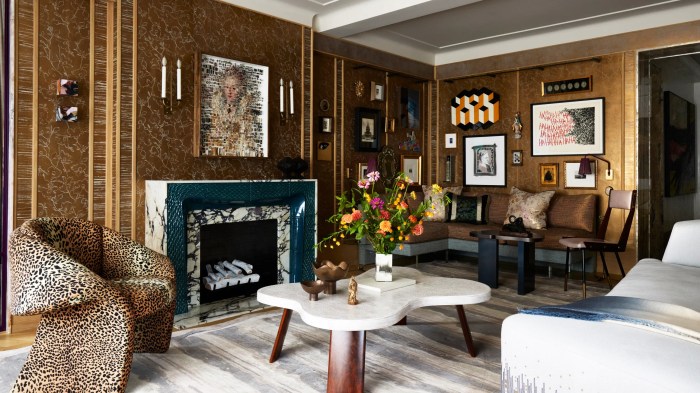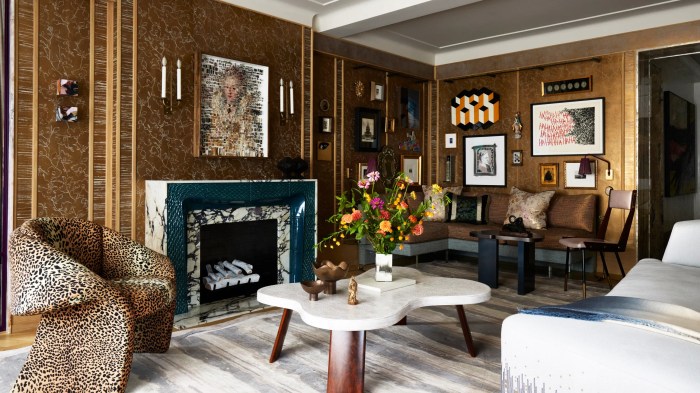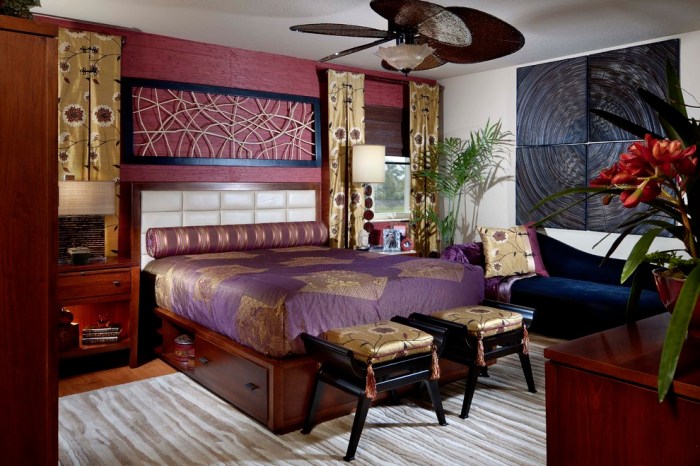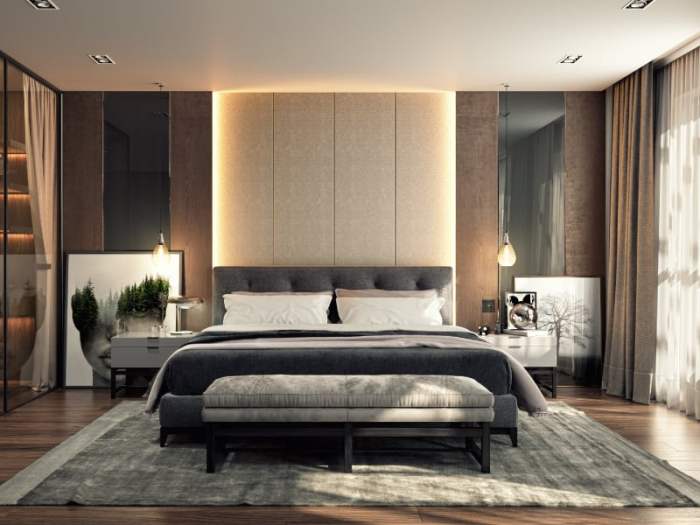Inspired Interiors: Creating Spaces That Inspire

Inspired interiors go beyond mere aesthetics; they’re about crafting spaces that evoke emotions, stimulate creativity, and reflect the unique spirit of the homeowner. This approach to design embraces a multitude of influences, from art and nature to personal experiences and cultural trends, weaving them into a tapestry of textures, colors, and objects that resonate with the soul.
This exploration delves into the essence of inspired interiors, unveiling the secrets behind their captivating allure. We’ll uncover the key elements that contribute to their unique character, from carefully curated color palettes to the strategic use of lighting and materials.
We’ll also explore how different design styles, from bohemian to minimalist, embody the spirit of inspired interiors, showcasing their distinct features and the iconic designers who have shaped their evolution.
Defining Inspired Interiors

Inspired interiors go beyond mere aesthetics; they embody a unique blend of functionality, personal expression, and a touch of magic. Unlike conventional design styles that adhere to strict rules and guidelines, inspired interiors embrace individuality and draw inspiration from a multitude of sources, creating spaces that are both visually captivating and deeply personal.
Key Elements of Inspired Interiors
Inspired interiors are characterized by a harmonious interplay of various elements that come together to create a cohesive and inspiring atmosphere.
Color Palettes
The color palette is a fundamental element in creating an inspired interior. Colors evoke emotions and influence mood, making them powerful tools for setting the tone of a space. While there are no hard and fast rules, inspired interiors often feature a balanced use of both warm and cool tones, creating a sense of depth and visual interest.
For instance, a calming blue can be paired with a vibrant orange to create a dynamic and inviting atmosphere.
Materials
The materials used in an inspired interior play a crucial role in shaping the overall aesthetic and feel of the space. Natural materials like wood, stone, and textiles bring warmth and authenticity, while contemporary materials such as metal and glass can add a touch of modernity and sophistication.
The choice of materials should be guided by the desired mood and functionality of the space. For example, a rustic farmhouse kitchen might incorporate reclaimed wood beams and exposed brick, while a sleek and modern living room might feature polished concrete floors and sleek metal accents.
Textures
Texture adds depth and dimension to an inspired interior, creating a tactile experience that engages all the senses. Combining different textures, such as smooth velvet upholstery, rough-hewn wood, and woven textiles, can create a rich and layered aesthetic. The interplay of textures can also contribute to a sense of visual interest and excitement.
For instance, a room with a predominantly smooth surface might benefit from the addition of a textured rug or a piece of art with a textured surface.
Lighting
Lighting is an often-overlooked element in interior design, but it plays a crucial role in shaping the mood and ambiance of a space. Inspired interiors use a combination of natural and artificial light to create a balanced and inviting atmosphere.
Creating an Inspired Atmosphere

An inspired interior is not merely about aesthetics; it’s about creating a space that evokes a sense of joy, tranquility, and creativity. This section delves into practical strategies for crafting a living room that radiates inspiration, focusing on elements that contribute to the overall mood.
Designing a Living Room that Embodies Inspired Interiors
A living room that embodies the “inspired interior” aesthetic is a harmonious blend of functionality, beauty, and personality. It’s a space that invites relaxation, stimulates creativity, and reflects the homeowner’s unique style. Here are some key elements to consider:
- Natural Light: Maximize natural light by using large windows and minimizing obstructions. Natural light has a profound impact on mood and energy levels, fostering a sense of well-being and inspiration.
- Neutral Color Palette: Opt for a neutral color palette as the foundation for your living room. Neutral colors create a sense of calm and allow other elements, such as furniture, artwork, and accessories, to stand out. Think of soft creams, warm grays, or earthy browns as your base.
- Statement Piece: Incorporate a statement piece that captures your personality and becomes a focal point of the room. This could be a unique piece of furniture, a vibrant rug, or a captivating piece of artwork.
- Textured Elements: Introduce texture through different fabrics, materials, and finishes. Textured surfaces add depth and interest, creating a multi-sensory experience that engages the touch and sight.
- Greenery: Bring the outdoors in with plants. Greenery adds a touch of life, color, and freshness, contributing to a sense of tranquility and inspiration. Consider low-maintenance plants that thrive in indoor environments.
Incorporating Personal Touches and Meaningful Objects
A truly inspired interior is a reflection of the homeowner’s personality and experiences.
- Family Heirlooms: Display family heirlooms or treasured objects that hold sentimental value. These items tell stories, connect you to your past, and create a sense of history and belonging.
- Travel Souvenirs: Incorporate souvenirs from your travels.
- Artwork: Display artwork that inspires you. Whether it’s paintings, sculptures, photographs, or prints, choose pieces that resonate with your emotions and aesthetic sensibilities.
- Books: Arrange bookshelves filled with books that reflect your interests. Books are not only functional but also visually appealing, adding a touch of intellectualism and personality to the space.
- Collections: Showcase your collections, whether it’s vintage cameras, antique teacups, or seashells. Collections add a personal touch and demonstrate your passions.
Color Palettes and Lighting Techniques
Color palettes and lighting techniques play a crucial role in shaping the mood and atmosphere of a space.
- Color Psychology: Consider the psychological effects of colors. Warm colors like reds, oranges, and yellows can stimulate energy and creativity, while cool colors like blues, greens, and purples promote calmness.
- Layered Lighting: Utilize a combination of ambient, task, and accent lighting. Ambient lighting provides general illumination, task lighting illuminates specific areas for activities, and accent lighting highlights features or artwork.
- Natural Light Enhancement: Maximize natural light by using light-colored walls and furniture, and incorporating mirrors to reflect light. This creates a sense of spaciousness and brightness.
- Dimmable Lighting: Install dimmable lighting to adjust the brightness according to the mood or activity. Soft, warm lighting creates a cozy and inviting atmosphere, while brighter lighting is ideal for working or reading.
Inspired Interior Design Styles

Inspired interior design styles go beyond simply furnishing a space; they reflect a unique aesthetic philosophy and evoke a specific mood or feeling. These styles often draw inspiration from cultural movements, historical periods, or artistic trends.
Exploring Diverse Inspired Interior Design Styles
Inspired interior design styles encompass a broad spectrum of aesthetics, each characterized by distinct elements and a unique approach to space. These styles are not merely decorative trends; they reflect a deeper understanding of how design can impact our emotions and well-being. Bohemian: Characterized by a free-spirited and eclectic approach, Bohemian interiors embrace a mix of textures, patterns, and colors. Inspired by the unconventional lifestyles of artists and travelers, this style often features vintage furniture, handcrafted textiles, and global souvenirs. Think layered rugs, macrame wall hangings, and vibrant tapestries. Iconic designers associated with Bohemian style include:
-
- Miles Redd: Known for his vibrant color palettes and eclectic mix of patterns, Redd seamlessly blends vintage and contemporary pieces to create spaces that are both sophisticated.
- Kelly Wearstler: With a signature blend of modern and vintage elements, Wearstler’s designs often feature bold colors and luxurious textures.
- Minimalist: Defined by its simplicity and functionality, minimalist interiors prioritize clean lines, neutral colors, and a sense of order. This style focuses on essential pieces, avoiding clutter and unnecessary ornamentation. The emphasis is on creating a sense of calm and tranquility, allowing the beauty of the space to speak for itself.
- Dieter Rams: A pioneer of minimalist design, Rams is renowned for his functional and timeless designs, exemplified by his iconic Braun products.
- Mies van der Rohe: Known for his “less is more” philosophy, van der Rohe’s designs are characterized by clean lines and open spaces.
- Eclectic: Eclectic interiors celebrate a fusion of styles, periods, and cultures. This style encourages a playful approach to design, blending unexpected elements to create a unique and personal space. Think vintage finds alongside modern pieces, bold patterns paired with neutral tones, and a mix of textures and materials.
- Jonathan Adler: Known for his bold patterns, vibrant colors, and eclectic mix of styles, Adler’s designs are both whimsical.
- Nate Berkus: A champion of mixing styles and textures, Berkus’s designs often feature a blend of vintage finds and modern pieces.
- Scandinavian: Embracing simplicity and functionality, Scandinavian interiors prioritize natural materials, light colors, and a focus on comfort. This style is known for its clean lines, minimalist furniture, and use of natural light. Think pale wood, white walls, and soft textiles.
- Arne Jacobsen: A pioneer of Danish modernism, Jacobsen’s designs are known for their clean lines and functional forms.
- Eero Saarinen: Renowned for his iconic furniture designs, Saarinen’s work is characterized by its organic forms and innovative materials.
Defining Elements of Inspired Interior Design Styles
Each inspired interior design style is characterized by a set of defining elements that contribute to its unique aesthetic. These elements, ranging from color palettes and furniture choices to lighting and accessories, work together to create a cohesive.
| Inspired Interior Design Style | Defining Elements | Iconic Designers |
|---|---|---|
| Bohemian | An eclectic mix of textures, patterns, and colors; vintage furniture; handcrafted textiles; global souvenirs; layered rugs; macrame wall hangings; vibrant tapestries. | Miles Redd, Kelly Wearstler |
| Minimalist | Clean lines; neutral colors; essential pieces; focus on functionality; sense of order; calm and tranquil atmosphere. | Dieter Rams, Mies van der Rohe |
| Eclectic | Fusion of styles, periods, and cultures; a playful approach to design; unexpected elements; vintage finds alongside modern pieces; bold patterns paired with neutral tones; a mix of textures and materials. | Jonathan Adler, Nate Berkus |
| Scandinavian | Natural materials; light colors; clean lines; minimalist furniture; focus on comfort; use of natural light; pale wood; white walls; soft textiles. | Arne Jacobsen, Eero Saarinen |
Inspired Interior Design Trends

Inspired interior design is a constantly evolving field, reflecting global influences, cultural movements, and emerging technologies. These trends shape our living spaces, reflecting our values, aspirations, and the way we live.
Global Influences and Cultural Movements, Inspired Interiors
Global influences and cultural movements play a significant role in shaping contemporary interior design trends. This exchange of ideas and aesthetics creates a rich tapestry of styles, blending traditional elements with modern sensibilities.
- Japanese Wabi-Sabi: This philosophy emphasizes the beauty of imperfection and the acceptance of transience. Wabi-sabi interiors often feature natural materials, muted colors, and a sense of calm and serenity. Examples include incorporating natural wood, bamboo, and stone elements, along with simple, handcrafted furniture.
- Scandinavian Minimalism: Known for its clean lines, functionality, and use of natural light, Scandinavian minimalism emphasizes simplicity and functionality. White and neutral colors are prevalent, along with natural materials like wood and leather. Minimalist Scandinavian interiors prioritize open spaces and a sense of order.
- Bohemian Eclecticism: This style celebrates individuality and a mix of textures, patterns, and colors. Bohemian interiors often feature global textiles, vintage furniture, and eclectic artwork, creating a unique and personal space.
Sustainable and Eco-Friendly Design Practices
Sustainable and eco-friendly interior design practices are gaining momentum as consumers become increasingly aware of the environmental impact of their choices. These practices prioritize the use of sustainable materials, energy efficiency, and responsible sourcing.
- Recycled and Upcycled Materials: Using recycled materials, such as reclaimed wood, repurposed furniture, and recycled glass, reduces waste. Upcycling involves transforming discarded materials into new, functional pieces, giving them a second life.
- Bio-Based Materials: Bio-based materials, derived from renewable sources like plants and bamboo, are gaining popularity as sustainable alternatives to traditional materials. These materials offer a lower carbon footprint and contribute to a healthier indoor environment.
- Energy-Efficient Design: Incorporating energy-efficient lighting, appliances, and building materials can significantly reduce energy consumption and contribute to a more sustainable home. This includes using LED lighting, smart thermostats, and well-insulated windows.
Incorporating Elements of Nature
Bringing the outdoors in is a key trend in inspired interior design.
- Natural Materials: Using natural materials like wood, stone, bamboo, and cork brings warmth, texture, and a sense of connection to the natural world. These materials create a calming and grounding effect, fostering a sense of well-being.
- Biophilic Design: Biophilic design incorporates elements of nature into the built environment, creating a sense of connection and improving well-being. This can include incorporating plants, natural light, water features, and views of nature.
- Natural Light: Maximizing natural light is crucial for creating a bright, airy, and inspiring space. Large windows, skylights, and light wells allow natural light to flood the interior, improving mood and productivity.
Final Wrap-Up

In the realm of inspired interiors, the journey of design becomes a personal narrative, one that celebrates individuality and fosters a sense of well-being. Whether you’re seeking to infuse your living room with a touch of bohemian charm, embrace the simplicity of minimalist design, or create a space that reflects your love for nature, the principles of inspired interiors offer a framework for crafting a home that truly inspires.
Comments are closed.